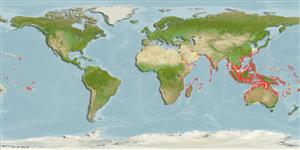Common names from other countries
分类 / Names
俗名 | 同种异名 | Catalog of Fishes(属, 种) | ITIS | CoL | WoRMS | Cloffa
Issue
Genetic data indicate the presence of cryptic species with partial parapatric distribution. The species Paniliza macrolepis may be limited to West Indian Ocean lineages (Durand & Borsa (2015: Ref. 114224).
Environment: milieu / climate zone / depth range / distribution range
生态学
海洋; 淡水; 半咸淡水 居于水底的; 降海洄游 (Ref. 46888); 深度上下限 10 - ? m (Ref. 40448). 熱帶; 32°N - 35°S, 22°E - 136°W
Indo-Pacific: east coast of Africa, south to Eastern Cape in South Africa (Ref. 52193), including Madagascar, Seychelles, Rodriguez; north to Sri Lanka and India (except Bay of Bengal), Andaman and Nicobar Islands, east to Indonesia, China, the Philippines, Japan, Marshall and Tuamoto islands, Melanesia and Polynesia (Ref. 2830). Distribution includes the Red Sea (Ref. 84159) and Persian Gulf (Ref. 66734).
印度-太平洋: 非洲東岸,包括馬達加斯加,塞錫爾群島, 羅德里格斯; 北至斯里蘭卡與印度 (除了紅海, 波斯灣與孟加拉以外), 安達曼群島與尼古巴群島, 東至印尼,中國,菲律賓,日本,馬紹爾群島與 Tuamoto 島,美拉尼西亞與玻利尼西亞.(參考文獻 2830)
Length at first maturity / 大小 / 重量 / 年龄
Maturity: Lm 23.0 range ? - ? cm
Max length : 60.0 cm SL 雄鱼/尚未辨别雌雄; (Ref. 4967); common length : 26.0 cm SL 雄鱼/尚未辨别雌雄; (Ref. 4967); 最大年龄: 6 年 (Ref. 127264)
背棘 (总数) : 4 - 5; 背的软条 (总数) : 8 - 9; 臀棘: 3; 臀鳍软条: 8 - 10.
呈绿色的-灰色的背面; 侧面与腹部银色的; 鳍灰色的或蓝色的有暗色的边缘而且可能在基底显得淡黄色的.(参考文献 9812) 胸鳍有金色的基底, 与也许一个深色的斑点.(参考文献 9812) 有不发达的腋窝鳞片。
Occur in shallow coastal waters, and from brackish water to freshwater regions of rivers (Ref. 41299). Form schools (Ref. 40448); in larger aggregations during spawning, which takes place at sea (Ref. 2830). Feed on small algae, diatoms, forams, benthic polychaetes, crustaceans, mollusks, organic matter and detritus; fry feed on copepods and floating algae (Ref. 40448). Oviparous, eggs are pelagic and non-adhesive (Ref. 205). Caught mainly during the spawning season and is sold fresh; the roe is highly appreciated.
出现于沿岸浅水区, 与从半淡咸水到河的淡水区域.(参考文献 41299) 形成鱼群;(参考文献 40448) 在较大的群集中,在产卵的时候,这在海上发生。 (参考文献 3468) 吃小的藻类,硅藻,有孔动物,底栖性多毛类动物,甲壳动物,软件动物,有机物与碎屑; 鱼苗吃桡脚类的动物与漂浮藻类。 (参考文献 40448) 主要地在产卵季节的时候捕捉而且被卖生鲜地了; 鱼白高度地被欣赏。
Life cycle and mating behavior
Maturities | 繁殖 | Spawnings | Egg(s) | Fecundities | 仔鱼
印度-太平洋: 非洲東岸,包括馬達加斯加,塞錫爾群島, 羅德里格斯; 北至斯里蘭卡與印度 (除了紅海, 波斯灣與孟加拉以外), 安達曼群島與尼古巴群島, 東至印尼,中國,菲律賓,日本,馬紹爾群島與 Tuamoto 島,美拉尼西亞與玻利尼西亞.(參考文獻 2830)
Nakabo, T., 2002. Fishes of Japan with pictorial keys to the species, English edition I. Tokai University Press, Japan, pp v-866. (Ref. 41299)
CITES (Ref. 128078)
Not Evaluated
人类利用
渔业: 商业性; 养殖: 商业性; 游钓鱼种: 是的
工具
特别资料
下载 XML
网络资源
Estimates based on models
Preferred temperature (Ref.
115969): 24.5 - 29, mean 28 (based on 810 cells).
Phylogenetic diversity index (Ref.
82804): PD
50 = 0.5078 [Uniqueness, from 0.5 = low to 2.0 = high].
Bayesian length-weight: a=0.01288 (0.01051 - 0.01579), b=2.93 (2.90 - 2.96), in cm Total Length, based on LWR estimates for this species (Ref.
93245).
营养阶层 (Ref.
69278): 2.8 ±0.17 se; based on food items.
回复力 (Ref.
120179): 低的, 最小族群倍增时间4.5 - 14 年 (K=0.10).
Fishing Vulnerability (Ref.
59153): Moderate to high vulnerability (49 of 100).
